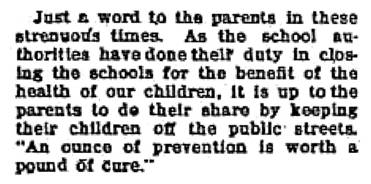A Fictitious 'Normal'
Life was supposed to feel normal, but it wasn't - not in Hicksville , not anywhere. It was as if the world was beset by an unending earthquake, one that suddenly toppled people, not buildings. One after another, schools were shuttered as towns tried to protect their most precious resource: their children.

This excerpt, and the one in used in the header,
are taken from the Hicksville section of the
Huntington Long-Islander for October 25, 1918
No one took the trouble to coin the phrase "social distancing," but clearly, people understood the idea well enough where their children were concerned. If you kept your family's children at home, isolating them from others who might be sick, they just might survive.
Adults were another matter. Everyone had to work, especially when there was a war on. And people needed to kick back and socialize now and then; everybody knew that. When parents came home, they would kiss and hug their families. Their children would look to see if their fathers had brought them candy or little gifts. Children's eyes were too innocent to notice any tiny viruses.
Paradoxically, parents who kept their children home from school would take them to the many festive government-sponsored rallies created to support the war effort. The rallies were like little county fairs: parades, military bands, exhibits of machines (in this case, weapons). Parents were excused from work. Children shared the excitement with the friends from whom they normally were isolated, running to line up together, sharing cups of lemonade. In dreary wartime, the rallies seemed like gifts from the government.

James Bourgholtzer, Victory Loan ceremony, c.1918
U.S. National Archives, Public Domain Archive
This is NOT Hicksville, but comparable displays were set up in
Long Island towns. People flocked together when they saw them;
boys especially were eager to touch artillery pieces or tanks.
No one had been told that the nation's top medical experts had urged the Wilson administration not to stage parades or rallies like these, for fear that such events would magnify the spread of the lethal epidemic. Indeed, during the entire epidemic, the President would make no public mention of it.
The government wanted life to be as normal as possible. It even went so far as to urge the mourning mothers of dead servicemen to wear white, not black, so that they would not stand out so much in public. Woodrow Wilson had visited England , and noticed mothers in black all over; he had found them depressing.
It was not only Mr. Wilson who was silent, for there was an ample supply of like-minded men willing to serve in his administration. News about the war and the epidemic was controlled - sometimes censored outright - by the Committee on Public Information (think of Orwell's book 1984), which was concerned less with Americans' well-being, and more with the impact of public morale on the war. The Committee's head, Arthur Bullard, once famously said:
"The force of an idea lies in its inspirational value. It matters very little if it is true or false."
The administration did its best to censor news reports that might reveal the epidemic's breadth and depth, for fear that public resolve to win the war might be weakened. Although theoretically in the dark, the people were not as stupid, or as blind, as the government seemed to think. Schools were closed nearly everywhere. Newspapers carried more obituaries than before, sometimes more pages of obituaries. Many funeral directors had to store filled coffins outside their establishments. In Queens, St. John Cemetery was using a steam shovel to dig temporary mass graves for them; another cemetery was storing them in its utility sheds.
The Hicksville section in the Huntington Long-Islander added an "Our Sick" column, in effect warning its readers about who in the village might pass away before next week's edition of the paper arrived. Despite the gravity of content, today's cynical reader may smile when reading through the obituaries. Whether for fear of censorship, or simply because the Long-Islander's writers worried about repeating the same dreaded word too often, not very many deaths were ascribed to "flu" or "influenza." Instead, many people were suddenly dying of "the grip" (a 19th century word for influenza), or of pneumonia (the most common consequence of this influenza; in Nassau County, 25% of the influenza victims who developed pneumonia died of it).
Normal? Life in 1917 had been normal. Life in 1918 was terrifying.

